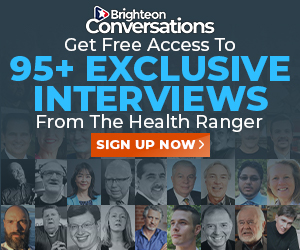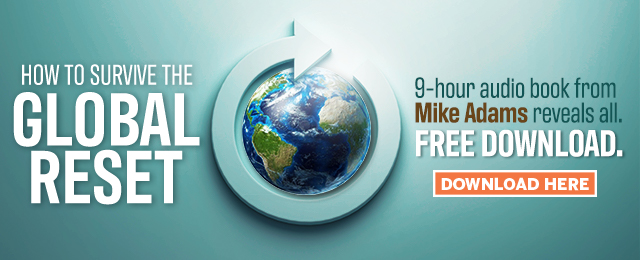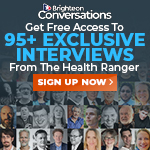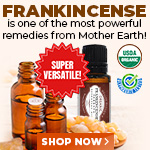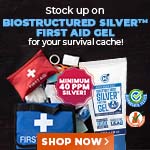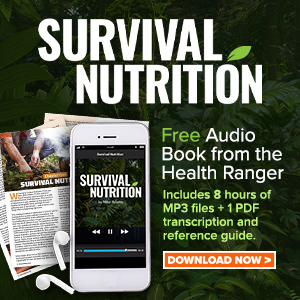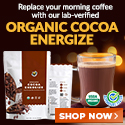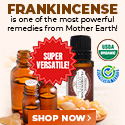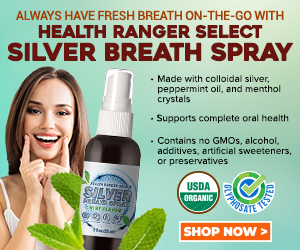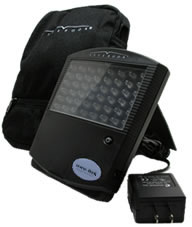
Interview: Larry Pederson and the LiteBook portable phototherapy device
 Monday, July 24, 2006 Monday, July 24, 2006by Mike Adams, the Health Ranger Editor of NaturalNews.com (See all articles...) Tags: phototherapy, sleep disorders, SAD |
- Aerosolized bioweapons? Strange “diploid biomasses” falling out of the sky in Florida captured under the microscope
- Tesla unveils enhanced Optimus robot, now walks better than Joe Biden!
- Newly released JFK files reveal Pentagon's role in creating Lyme disease and covid in the same lab
- Dr. Mary Talley Bowden drops bombshells about children being permanently damaged by mRNA jabs during Tucker Carlson interview
- “Immortality Herb” becoming more popular as an ADAPTOGEN – providing stress relief and immune modulation
- COVID mRNA injections linked to genetic changes that increase brain tumor and leukemia risk
- Florida skies contaminated: Shocking levels of aluminum, mercury, and lead found in atmospheric fallout
- Trump’s tariff shockwave sends Wall Street reeling as global recession fears mount
- After Jenny McCarthy's son got AUTISM FROM MMR VACCINE, a PR Firm was hired by U.S. government agency to label her an "ANTI-VACCINE KOOK"
- Staying connected: The essential guide to disaster communication by Jim Cobb
- Tofu: Health benefits, nutrients and how to eat this superfood
- Defunding DEADLY mRNA jabs: Government funding for mRNA technology being scrutinized and sidelined until proven "safe and effective" for real
- “Prepare Tribe: Prepare, Protect, Provide” on BrightU: Effective homesteading techniques and medical must-haves
- Microsoft scales back AI data center boom as China's DeepSeek upends the market
- Former CDC Director advocates for additional MMR dose for babies, going against decades of vaccine safety recommendations
- Tornado outbreak and flash floods gripping the Midwest: Days of devastation await
- Trump’s shift in policy could save American farmers from climate regulations and bureaucratic red tape
- California’s gas prices: A crisis of its own making, USC study finds
- Newly released JFK files reveal Pentagon's role in creating Lyme disease and covid in the same lab
- European Court of Justice: Healthcare professionals who promoted or administered COVID-19 vaccines are CRIMINALLY LIABLE for any harm caused
- Oncologist warns of ‘terrifyingly aggressive’ cancers in children, linked to immune suppression from COVID vaccines
- Kiss Your Genetic Privacy Good-Bye! 23andMe Gets Green Light to Sell Your Intimate Genetic Details to Anyone They Want
- Aerosolized bioweapons? Strange “diploid biomasses” falling out of the sky in Florida captured under the microscope
- Analysis: The coming economic collapse, a mass uprising and Trump's three secret weapons to halt the growing revolt
- Britain’s descent into police state censorship: Parents raided for questioning their daughter’s school system online
- AI weather model outperforms traditional forecasts, boosts accuracy by 20%
- Woman contracts WORLD'S DEADLIEST VIRUS after unknowingly being given the WRONG VACCINE
- NIH study, buried for decades, reveals that Flu Shots INCREASE elderly deaths, not prevent them
- Utah governor allows ban on LGBT pride flags in public buildings and schools, will take effect without his signature
- DARPA: The shadowy innovator behind the world’s most advanced military technologies
- The Health Ranger releases “Vaccine Zombie” song and music video, using AI-animated zombies for the music video
- COVID-19 scandal linked to CANCER SURGE: Billionaire researcher sounds alarm
- Musk targets “strangely wealthy” lawmakers in DOGE probe, names Pelosi, McConnell, Schumer
- Mike Adams releases country western hit single: Goin’ Back in Time is Comin’ Home
- When antibiotics are unavailable, natural ANTIMICROBIAL compounds become essential first line defenses against infection
- Ancient kitchen secrets REVEALED: How garlic, ginger and green onions fight cancer and heart disease
- Newly released JFK files reveal Pentagon's role in creating Lyme disease and covid in the same lab
- California's social media censorship law struck down: A victory for free speech or a threat to online safety?
- The Health Ranger releases “Vaccine Zombie” song and music video, using AI-animated zombies for the music video
- Dr. Mike Yeadon releases 15-minute testimony - WATCH - about genocidal intent of COVID “vaccines”
- EPA advisor admits the agency is funneling billions to climate groups ahead of Trump’s return to White House
- Florida takes a stand: DeSantis proposes permanent ban on mRNA vaccine mandates
- Rep. Nancy Mace introduces bill to ban biological males from female facilities on federal property
- Sugarcane extract superior to cholesterol-lowering drugs?
- Mike Adams releases country western hit single: Goin’ Back in Time is Comin’ Home
- Survival 101: Effective EMF blocking techniques
- “Why we influenced the 2020 elections”: Facebook files reveal the coordinated effort to bury the Hunter Biden laptop story
- Unpacking the Lies That We’ve Been Fed – new song and music video released by Mike Adams, the Health Ranger
- Attorney and TikTok influencer explains how he was offered hundreds of dollars to make false claims about Trump, Republicans
- OpenAI whistleblower who dissented against how the company trained ChatGPT found dead
- House Intelligence Committee calls for the ARREST and PROSECUTION of Dr. Anthony Fauci
- CONSERVATIVES SOUND THE ALARM: Big Pharma and the Left trying to force $32 billion money grab from America’s seniors into year-end spending deal
- Pilots report mysterious lights 'moving at extreme speeds' across Oregon skies
- Midair collision near D.C. kills 67; Questions mount over preventable tragedy
- Red Cross issues warning to stop blood plasma donations from vaccinated people
- Scientists confirm: GENIUS brain function can be spontaneously unleashed in humans without any apparent cause
- EPA advisor admits the agency is funneling billions to climate groups ahead of Trump’s return to White House
- HYSSOP: What research reveals about the health benefits of this ancient holy herb
- Two containers with completed ballots fall out of truck in Florida
- Fully vaccinated about to see “tsunami” of illness and death, warns virologist
- Global leaders unite to clamp down on “misinformation” with UN-backed Cascais Declaration
- BREAKING: 2025 NDAA authorizes mandatory military draft of WOMEN across America… as Pentagon pursues global NUCLEAR war with both Russia and China at the same time
- Michael Yon warns of a ZIONIST TAKEOVER in Trump’s second administration
- Newly released JFK files reveal Pentagon's role in creating Lyme disease and covid in the same lab
- BOMBSHELL: DNA testing kits are a SCAM to develop ethnic-specific bioweapons
- Ozempic and Wegovy weight loss drugs are injectable LIZARD VENOM PEPTIDES that may unleash a devastating wave of organ failure… side effects align with symptoms of SNAKE BITES
- Israeli soldiers accused of even more torture and abuse in the West Bank
- These 13 countries just signed an agreement to engineer a global FAMINE by destroying food supply
- The Health Ranger releases “Vaccine Zombie” song and music video, using AI-animated zombies for the music video
- NASA admits that climate change occurs because of changes in Earth’s solar orbit, and NOT because of SUVs and fossil fuels
- RFK Jr. clears key hurdle: Sen. Susan Collins backs controversial HHS nominee, signaling a new era for health policy
- Sermon 30: How Jesus reveals Caesar’s FAKE CURRENCY and FALSE AUTHORITY
Larry Pederson: Yes -- nice to see you, Mike. It's my pleasure.
Mike: Great to be speaking with you, Larry. Now, tell us about this product. How does it work and how can it help us be healthier individuals?
Pederson:Well, it can help a lot of people. Basically, it's light therapy. Light therapy's been around for about 20 years. It was these big fluorescent light boxes that, for many years, took up half your desk -- and yes, they work. But, they were very inconvenient and a lot of people wouldn't use them very practically. So what we did is we came up with a way to harness the white light emitting diode -- or LED technology -- that was invented in Japan five or six years ago -- and what we found is that that LED actually keeps at a very specific wavelength that's identical to sunlight. So, if you're in an environment where you're not getting enough sunlight because you're living in the northern part of the United States, Northern Europe or Canada -- where we are -- or if you're a teenager and you're not getting up in the morning, or you're going to sleep at night and you're a senior or a shift worker -- there's many different applications. Light therapy is a natural solution for people that are looking for a way to improve their wellness and to feel better. It's not something that you swallow and there's no side effects and so forth. It's a very clean alternative solution to wellness.
Mike: This unit makes it portable, so it's great for treating jet lag especially.
Pederson: Exactly. We've actually developed a software program based on research done at NASA, and we put 171 cities around the world on our website. You put in your normal waking time to tell it what your body clock is set at -- your departure city, your arrival city, anywhere on the planet -- and it will tell you when to use this and for how long. And 45 minutes to an hour from the day you travel, you can reset your body clock to your new time zone. No more jet lag.
Mike: That's a great idea. You sort of pre-adjust instead of post-adjust.
Pederson: Exactly. You know, the body adjusts more slowly with age, so the rate at which it adjusts drops off dramatically at age 50. A lot of people are traveling as business people, and they get to that age where they have more responsibility at the peak of their careers -- and yet they're suffering more from jet lag.
Mike: Now, I think light therapy is very interesting, because it is accepted not only in natural health or naturopathic treatments, but also very well accepted in conventional medicine, correct?
Pederson: Absolutely. The American Psychiatric Association has basically endorsed light therapy for use not only for seasonal depression or Seasonal Affective Disorder, but also for a range of other disorders, including sleep disorders and delayed phase sleep syndrome -- which can affect teenagers -- and, there are a lot of different applications for seniors, and there's more emerging everyday.
Mike: How does light therapy actually work at a physiological level? You talked about receptors in the eye.
Pederson: Well, this is something -- this is pretty new science and new knowledge and basically, researchers discovered about four or five years ago that there's this little receptor, a photoreceptor, on the retina right now, and for years they've known that there were rods and cones, which together give us light. They take the signal in and they tell us what's light or dark. It gives us vision. They discovered this other photoreceptor called melanopsin. It's actually a protein that resides outside the fovia part of the retina, which is where the rods and cones are, so it has nothing to do with vision and everything to do with telling your body whether it's light or dark -- day or night. It regulates your body clock, and that's how and why most blind people know when to go to bed. They get that signal even if they have no vision. That photoreceptor actually looks for light, and it will tell the body based on the light it takes in to strike that photoreceptor -- and it looks for the peak wavelength of sunlight. The peak wavelength of sunlight is in the blue part of the spectrum -- it's 460 nanometers, to be specific -- and that is the peak wavelength of the LED lights we're using in the Litebook.
Mike: I see.
Pederson: When this light strikes your eye, it actually excites that little photoreceptor that tells the brain, "Okay, it's bright, you need to be alert," and it shuts down your melatonin. Melatonin is the hormone in your body that tells you to go to sleep at night and keeps you asleep throughout the night, and it gets shut off every morning when you open your blinds and the sunlight streams in.
Mike: So, this receptor is really directly wired to the endocrine system that controls all these cycles.
Pederson: Exactly. The suprachiasmatic nuclei (SCN), which is in the hypothalamus part of the brain -- it is actually the little body clock. It's our own internal body clock and it needs to be reset everyday.
Mike: So, there's a very clear and at least a somewhat understood physiological process that governs our energy when we're awake and when we feel sleepy.
Pederson: Also, our sleep cycle when we're trying to sleep at night. What's happened in our culture is that we've moved indoors in the last generation. From the time we were kids, we were outside all the time because there was nothing to do inside, right? My mother used to lock the door after us when we left the house during the day in the summertime. My parents never saw me in the summertime.
Mike: Right.
Pederson: Right, because there was nothing to do inside. But now -- with one generation -- we've moved indoors to the point where we're not getting that exposure to bright sunlight. You add to that the fact that UV and skin cancer and all these concerns now keep us from going out. The sun was perceived to be bad for us, when in fact, it's life giving. Without the sun, there is no life, right?
Mike: That's right.
Pederson: What we've done though, is we've harnessed these LEDs in a way that allows you to get the sunlight without actually needing to go to the sun. If you can't go to the sunlight, we bring the sunlight to you.
Mike: I'd like you to talk about this interesting lens here a minute, but first your comment about sunlight -- yes, people are recognizing now that some sunlight is very beneficial for the formation of vitamin D.
Pederson: Yes, absolutely.
Mike: But, just to be clear, this device doesn't emit ultraviolet light, correct?
Pederson: Correct. It will not do anything in the generation of vitamin D -- the production of vitamin D. What it will do, though, is it will affect your serotonin level in your brain. Serotonin is the feel-good neurotransmitter in the brain that Prozac, and that whole class of antidepressants, is meant to elevate -- they're the SSRI drugs.
Mike: Right.
Pederson: Sunlight also elevates serotonin, right?
Mike: Yes.
Pederson: That feeling you get on a nice sunny day when you're out there -- and you get that feeling in the sun that's actually a serotonergic response caused by the sunlight, right? Everyone feels better on a sunny day.
Mike: Yes.
Pederson: Right? That's what this light is giving you -- that same feeling that you get on a nice sunny day even when it's cloudy or rainy or overcast. It doesn't matter.
Mike: Do you hear that from a lot of users now? Now, I know you don't want to make medical claims, but do you hear testimonials from people about how it has helped their depression?
Pederson: Absolutely. We've had testimonials from many people that were taking antidepressants -- but we don't make any claims about this. We've done some clinical research on this, but we still have our pivotal FDA trial to do. But, the talk about it just improves -- the glass goes from being half empty to half full.
Mike: What other conditions or diagnosable disorders could this have potential for?
Pederson: Many people look at sleep. Sleep is really big in the media right now. A lot of people are talking about the issue of sleep -- sleep disorders. There's 88 different sleep disorders and a variety of them cannot and won't be affected by the issue of light. Things like sleep apnea -- obstructive sleep apnea, where your trachea collapses and so forth -- this won't help with that. But, a lot of people find that this, for example, addresses insomnia, because if you are exposed to more light during the day, you will sleep better at night -- and that's a fact.
Mike: Absolutely.
Pederson: Because, you're going to regulate your body clock and you're going to say, "This is the day and this is the night." Melatonin, which is the hormone that puts you to sleep at night and keeps you asleep, if it's suppressed -- if it's seeping out during the day -- then you're feeling tired, dragging and lethargic -- but the worst part is that the body only produces so much melatonin every 24 hours. When you go to sleep that night, you get what's left. You get a very unsatisfactory night's sleep. If, on the other hand, you suppress it first thing in the morning with a precisely timed exposure to bright light in the right wavelength -- which is what this delivers -- say for 15 minutes, your melatonin goes to zero almost immediately. You have more energy during the day and then when you go to sleep that night, you get the full burst of melatonin as nature intended and you get a much deeper, more restful sleep.
Mike: You understand these hormones and their cycles very well. I remember when I spoke to you a year ago -- you had a very interesting explanation I'd like to ask you to repeat. It was about why teenagers like to stay up all night and senior citizens like to go to bed early.
Pederson: The human body clock actually shifts ahead when you go through puberty, which is why my son -- who's 10 -- is in bed at 8:30 with lights out -- and he's asleep at 9:01. He sleeps like a rock through the night and then he wakes up at seven in the morning with a smile on his face. I know when he gets to be 12 years old, he's going to want to stay up all night and sleep all day. His body clock is shifted ahead. The problem is that he has to still get up and get on that school bus or get to that early class if he's in college or whatever.
Mike: Right.
Pederson: That's what happens, and so the teenager would need to use this light first thing in the morning for 15 minutes in order to shift the body clock back.
Mike: That's all it takes.
Pederson: Yes. At the other end of the life cycle, at menopause -- and both men and women go through menopause, but men don't like to admit it -- basically what happens is the body clock shifts back. Seniors -- like my mother -- would fall asleep at nine o'clock in front of the TV, wake up at four in the morning, and could not get back to sleep before she began using the Litebook. By using this light in the evening at the dinner hour, say for 15 to 30 minutes, she's able to tell the body, "No, it's still bright out and you need to be alert. Hold off on the melatonin and shift that melatonin secretion time to later in the evening," like it was when she was in her midlife. She can then go to sleep at 11 and sleep until six in the morning.
Mike: Makes perfect sense. Let's talk more about the Litebook unit itself.
Pederson: Sure.
Mike: It has a very interesting lens here on the front. What's the purpose of this?
Pederson: This is the new modified model that'll be coming out this fall, and what we've done is we've taken 48 LEDs, which used to have a sort of a plain diffuser over it, and we've replaced this with these fresnel lenses. Now, the fresnel lens was a technology invented over 100 years ago. Basically, it's sort of like the technology used in the lens of a movie set lamp, like a search spotlight or a theater light. Out of this light comes a divergent light from the light source, and bends the light out and sends it in a straight line. So, each LED now has its own little fresnel lens that together give it a much more uniform light with less glare.
Mike: Is this a patented feature of yours?
Pederson: Yes. The patent on the fresnel lens is now expired, so we don't have a patent on the lens. We have a patent on the LED technology. In a light therapy device, whether it's handheld or built into a car, a bus, a train, anything that uses LEDs for light therapy through the eyes is under our patent.
Mike: Wow. That's a fairly broad patent.
Pederson: Yes it is. It's in the U.S., Canada and now in Europe as well, and we have others pending.
Mike: What about the battery life of this unit?
Pederson: We use a lithium ion rechargeable battery similar to that used in a video camera. It gives you 90 minutes of light, fully charged. It charges at night like your cell phone. It has a timer function so that you have 15-, 30-, 45- or 60-minute settings, and it shuts off automatically. The battery is basically going to give you 90 minutes of light and yet it doesn't add depreciable weight because it's lithium ion.
Mike: Well, it's very light.
Pederson: Yes -- it's about 8 ounces.
Mike: And it's more of an environmentally safe battery than nickel cadmium.
Pederson: Right -- you're not throwing it away. You're recharging it and the LEDs themselves. I mean, talk about environmental issues -- they are rated to last up to 100,000 hours. Which is 12 years -- if it's on 24 hours a day, seven days a week.
Mike: So, it'll never burn out.
Pederson: No. It's a lifetime of light. Unlike a fluorescent tube or bulb -- which might give you 3,000 to 5,000 hours -- the LED will give you 100,000 hours. This unit uses two-and-a-half watts of power. The previous one you saw last year was six watts and the big fluorescent light box uses 85 watts.
Mike: Many consumers would say higher wattages are automatically better.
Pederson: Well, higher wattage is the power draw, so it's the power consumption. It doesn't have anything to do with the output. What they're realizing now is the output -- because it's so wavelength-dependent -- we have a targeted wavelength that we need to hit the photoreceptor with.
Mike: Yes.
Pederson: As it turns out for us and for everybody else's benefit, the white LED hits that wavelength right on the money. It's an exact alignment with that wavelength that the body responds to. So, it's a shorter treatment time, which is great in this day and age -- everything is lighter, faster, smaller, better.
Mike: Absolutely. Now, Larry, where can people find the Litebook or purchase it?
Pederson: Right now they would go to www.LiteBook.com -- we have a web store there. We also have a store locator, so you can go in and type in your zip code or your country code and it will then tell you where the closest dealers and resellers are. It's in some Whole Foods now in the Pacific Northwest. It'll be going into more Whole Foods, Wild Oats -- that kind of a channel as well -- and spas and some fitness clubs are now selling this. We're also starting to sell this in college bookstores for the university students.
Mike: That makes sense.
Pederson: We think so.
Mike: So, are you finding -- especially this year -- more acceptance to this technology?
Pederson: No question about it. It's because, even compared to last year, it's a dramatic increase in the awareness of how light can be helpful to people. I encounter a lot less skepticism now than I did last year, or certainly years in the past, and I think the science is catching up to the technology and the awareness -- so you kind of have this synergy of the three parts of the puzzle.
Mike: Absolutely. Well, we've been talking with Larry Pederson, the founder and creator of the Litebook product from The Litebook Company. Again, that's www.LiteBook.com, and this is the unit that will come out in the fall of 2006.
Pederson: September 2006.
Mike: Look for this at retailers all across North America. Thanks for sharing this information with us today, Larry.
Pederson: My pleasure. Thank you. Nice to see you again. Thank you.
Phototherapy at FETCH.news
Get independent news alerts on natural cures, food lab tests, cannabis medicine, science, robotics, drones, privacy and more.
 About the author:Mike Adams (aka the "Health Ranger") is a best selling author (#1 best selling science book on Amazon.com) and a globally recognized scientific researcher in clean foods. He serves as the founding editor of NaturalNews.com and the lab science director of an internationally accredited (ISO 17025) analytical laboratory known as CWC Labs. There, he was awarded a Certificate of Excellence for achieving extremely high accuracy in the analysis of toxic elements in unknown water samples using ICP-MS instrumentation. Adams is also highly proficient in running liquid chromatography, ion chromatography and mass spectrometry time-of-flight analytical instrumentation.
About the author:Mike Adams (aka the "Health Ranger") is a best selling author (#1 best selling science book on Amazon.com) and a globally recognized scientific researcher in clean foods. He serves as the founding editor of NaturalNews.com and the lab science director of an internationally accredited (ISO 17025) analytical laboratory known as CWC Labs. There, he was awarded a Certificate of Excellence for achieving extremely high accuracy in the analysis of toxic elements in unknown water samples using ICP-MS instrumentation. Adams is also highly proficient in running liquid chromatography, ion chromatography and mass spectrometry time-of-flight analytical instrumentation.
Adams is a person of color whose ancestors include Africans and Native American Indians. He's also of Native American heritage, which he credits as inspiring his "Health Ranger" passion for protecting life and nature against the destruction caused by chemicals, heavy metals and other forms of pollution.
Adams is the founder and publisher of the open source science journal Natural Science Journal, the author of numerous peer-reviewed science papers published by the journal, and the author of the world's first book that published ICP-MS heavy metals analysis results for foods, dietary supplements, pet food, spices and fast food. The book is entitled Food Forensics and is published by BenBella Books.
In his laboratory research, Adams has made numerous food safety breakthroughs such as revealing rice protein products imported from Asia to be contaminated with toxic heavy metals like lead, cadmium and tungsten. Adams was the first food science researcher to document high levels of tungsten in superfoods. He also discovered over 11 ppm lead in imported mangosteen powder, and led an industry-wide voluntary agreement to limit heavy metals in rice protein products.
In addition to his lab work, Adams is also the (non-paid) executive director of the non-profit Consumer Wellness Center (CWC), an organization that redirects 100% of its donations receipts to grant programs that teach children and women how to grow their own food or vastly improve their nutrition. Through the non-profit CWC, Adams also launched Nutrition Rescue, a program that donates essential vitamins to people in need. Click here to see some of the CWC success stories.
With a background in science and software technology, Adams is the original founder of the email newsletter technology company known as Arial Software. Using his technical experience combined with his love for natural health, Adams developed and deployed the content management system currently driving NaturalNews.com. He also engineered the high-level statistical algorithms that power SCIENCE.naturalnews.com, a massive research resource featuring over 10 million scientific studies.
Adams is well known for his incredibly popular consumer activism video blowing the lid on fake blueberries used throughout the food supply. He has also exposed "strange fibers" found in Chicken McNuggets, fake academic credentials of so-called health "gurus," dangerous "detox" products imported as battery acid and sold for oral consumption, fake acai berry scams, the California raw milk raids, the vaccine research fraud revealed by industry whistleblowers and many other topics.
Adams has also helped defend the rights of home gardeners and protect the medical freedom rights of parents. Adams is widely recognized to have made a remarkable global impact on issues like GMOs, vaccines, nutrition therapies, human consciousness.
In addition to his activism, Adams is an accomplished musician who has released over a dozen popular songs covering a variety of activism topics.
Click here to read a more detailed bio on Mike Adams, the Health Ranger, at HealthRanger.com.
Take Action: Support Natural News by linking to this article from your website
Permalink to this article:
Embed article link: (copy HTML code below):
Reprinting this article:
Non-commercial use OK, cite NaturalNews.com with clickable link.
Follow Natural News on Facebook, Twitter, Google Plus, and Pinterest
Science News & Studies
Medicine News and Information
Food News & Studies
Health News & Studies
Herbs News & Information
Pollution News & Studies
Cancer News & Studies
Climate News & Studies
Survival News & Information
Gear News & Information
News covering technology, stocks, hackers, and more



"Big Tech and mainstream media are constantly trying to silence the independent voices that dare to bring you the truth about toxic food ingredients, dangerous medications and the failed, fraudulent science of the profit-driven medical establishment.
Email is one of the best ways to make sure you stay informed, without the censorship of the tech giants (Google, Apple, Facebook, Twitter, YouTube, etc.). Stay informed and you'll even likely learn information that may help save your own life."
–The Health Ranger, Mike Adams











